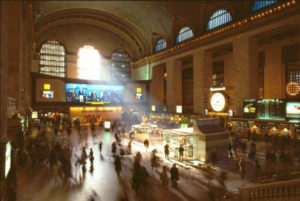 As a kid growing up in the early 60s, I used to take a train to Connecticut to visit my father. The adventure would begin at Grand Central station, where, after saying goodbye to my mother, I’d be on my own. I’d buy my ticket, get some magazines and gum, then hang around the Main Concourse, feeling very adult. I suppose I looked at the famous four-faced clock, though I didn’t know it was anything special.
As a kid growing up in the early 60s, I used to take a train to Connecticut to visit my father. The adventure would begin at Grand Central station, where, after saying goodbye to my mother, I’d be on my own. I’d buy my ticket, get some magazines and gum, then hang around the Main Concourse, feeling very adult. I suppose I looked at the famous four-faced clock, though I didn’t know it was anything special.
What I mostly remember were the twinkling stars on the vaulted ceiling and the glowing Coloramas, those billboard-size advertisements for Kodak, which depicted impossibly perfect people in impossibly beautiful places. They changed every three weeks, so that, for every trip I made, there was a new one. Usually, they were geared to the seasons – hundreds of tulips in the spring, Alpine snows fields in the winter, fields of pumpkins in the fall and beach scenes in the summer.
Once called “the world’s largest photographs,” they had a 40-year-run from 1950 to 1990. Today, you can walk down to Times Square and see bigger, jazzier signs with animation and live-action, but they don’t have the magic of the old Coloramas.
They were literally gigantic slides, or transparencies, lit from behind, the way they are in a handheld viewer. The Concourse was much darker then. Many of the windows were still blackened-out from World War II and others were grimy from decades of cigarette smoke. The result was a panoramic image that was richer, sharper and more real than life itself.

And completely idealized. I’ve just been to a small gallery in Grand Central to see a show of 36 original Coloramas – almost all from the 60s – and, now, all these many years later, I was a little embarrassed to see how corny and absurdly wholesome their subjects looked. Of course, that was what all advertising looked like in the “Mad Men” era. And, the subjects were usually chosen by Kodak executives, not the photographers.
More importantly, these are only approximations of the real thing. The originals were 18 feet tall and 60 feet wide. These are only 2 feet high and 5 feet wide, and are prints, not illuminated transparencies. Deprived of their scale and inner light, all that is left is their weakest attribute – content.
Still, it’s fun to see them and to learn how they were done. Various large-format cameras were used, including the so-called banquet camera, which produced the wide-angle, panoramic image. At the Eastman Kodak labs in Rochester, the image was enlarged and transferred to strip of transparency film that was 19 inches wide and 20 feet long. It took 41 of these panels to make the billboard-size image. Later, 40-inch film was used, and the number of separate panels reduced to 20.

The fantasy of a vacation spot reached by a private plane seems to have enchanted the Kodak executives. In 1964, the plane is in a ski scene in the Swiss Alps and in 1066, it’s a seaplane tying up to the deck of a Lake Placid cottage.
The family ones seem to take their inspiration from Norman Rockwell, like that from 1964, in which a mother gives baths to small children while father snaps the picture with his Instamatic. Or the one of the mother pointing a home-movie camera at her daughter playing with her dollhouse. In others, Dad reads a story to the children, two kids break a wishbone at Thanksgiving dinner, and the family (plus dog) take a drive in their big white convertible. If you’re were a baby boomer, the Coloramas seemed to grow up with you. By 1966, it’s teen beach parties (note the girl’s flip hairdos and the two-piece, halter-top bathing suits). And by 1967, the scene is inside of a discotheque.
It’s an upbeat take on the decade – no Vietnam War, no civil rights struggle, no assassinations. But nobody expected anything less than a perfect world in the Colorama images. And every world looks perfect if you get far enough away from it, which is the case with the only picture not to feature a human being – or a camera. It’s the Earthrise as seen from the Lunar Orbiter in 1966, the first such picture ever taken of the Earth from the Moon’s perspective.

